Highlights from our 2016 Indigenous Art Exhibition Program
It’s been a really great year for our exhibition program, probably one of the most eclectic years we’ve ever had.
We’ve exhibited a wide range of artists from all around Australia. The program has included artists from indigenous owned and run art centres, as well as independent artists and famous artists from the past.
I’d like to highlight six works from this year’s exhibition program to provide more background on the artists and their technique. These are works that I particularly like, works that spoke to me in some way. But they are also works that highlight the strength of Indigenous art in Australia, in all of its forms.
Bedford Station by Rover Thomas
The first piece is by Rover Thomas Joolama, a very early and important work. It’s now rare to see works from this artist of this size and age outside of museums.
Rover is recognised as one of the greats of the Indigenous Fine Art movement. He was the first Indigenous artist to represent Australia at the Venice Biennale. In some ways he really established the recognition of Australian Indigenous fine art around the world.
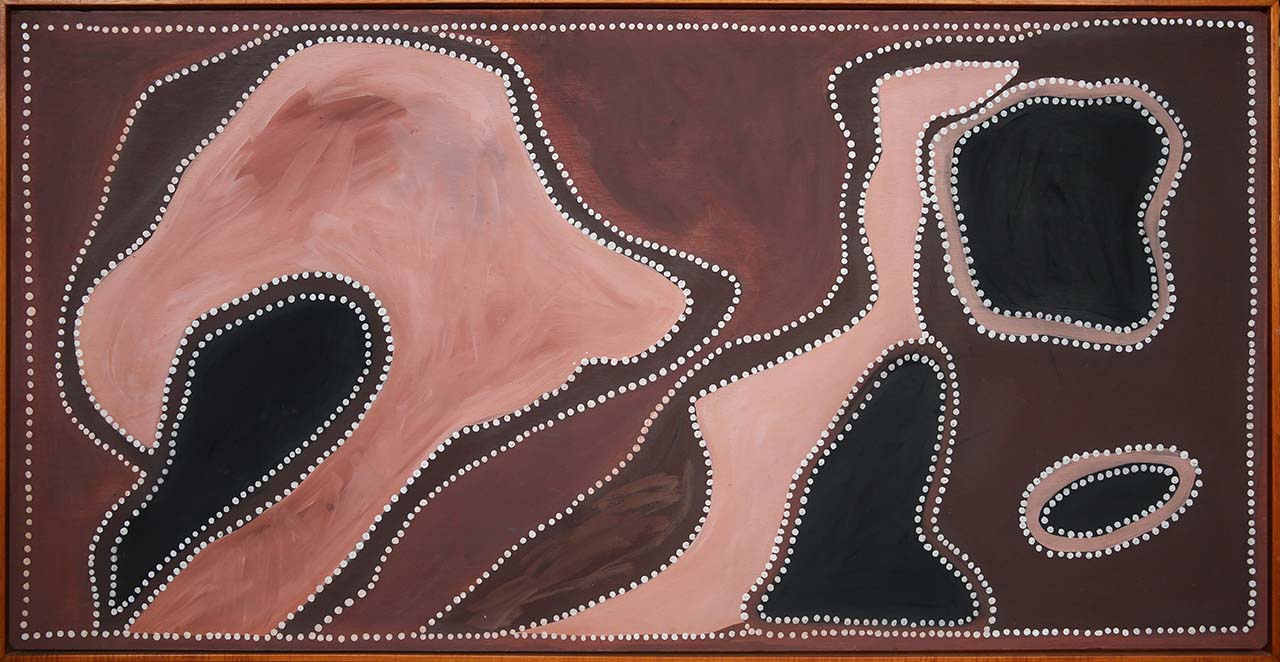
This particular painting is one of Rover’s earlier works from about 1985. It epitomises everything about Rover Thomas and what seemed to be his mantra of less is more. His paintings are incredibly spare and appear to be simple. In reality they are incredibly complex and beautiful artworks.
The other part of his life that this painting really captures is his other mantra, which was really brought to the fore in the title of one of his books – “I Love To Paint.”
Rover Thomas was so driven to paint, if he didn’t have the materials to hand to paint on, he would use whatever he could find. In this particular instance, he’s painted on a sheet of plywood that I think would have been used for part of a door panel. That’s all the material he had to hand. He’s used his traditional, natural ochre pigment and he’s painted it in a masterly and creative way to create this artwork that has easily withstood the test of time.
The painting is still on view in the gallery, and many people come here just to view this particular painting.
So Bedford Station easily makes it into my top six list for this year.
Ngarrk Ngarrk by Alan Joshua Jr
One of the other paintings that I love from this year would be from a different area entirely. It’s from one of our long-term favourite communities. It’s called the Ngukurr Art Centre. It’s an Indigenous owned, run art centre on the Roper River in Northern Territory. It’s a very remote community but it’s had some very famous artists through its doors over the years.
Unlike many art centres, it doesn’t have a specific look. It’s so varied; the artists themselves all come from different language groups, and it’s sort of reflected in the myriad styles that are employed. Some are naïve, some are incredibly complex. Some of the more famous artists from this community include Gertie Huddleston, who’s recognised as one of the greats. She lived in the mission up there with her sister. They went on to become very famous artists.
One of the artists and a particular painting that caught my eye from this show was by Alan Joshua Jr. It’s quite an incredible work; almost modernist painting. It really stands out.
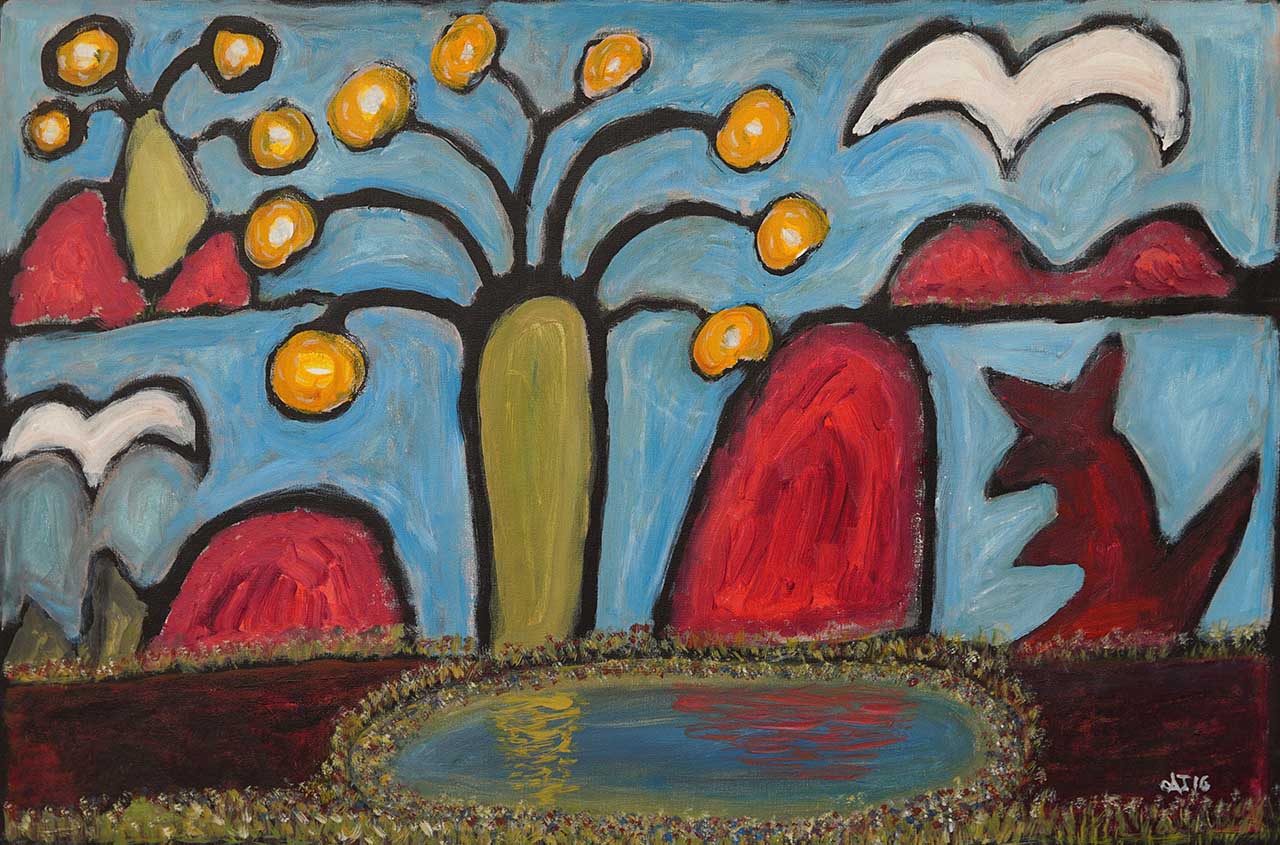
It is the painting of country. It’s got Boab trees, it’s got a kangaroo, the rock formations, birds flying in the sky. It’s slightly naïve yet also so sophisticated. It uses very strong, bright, primary colours. It immediately caught my eye, and I am still really drawn to it.
Ngarrk Ngarrk is not a big painting – it’s 88 centimetres by 59 centimetres. It’s a painting that is slightly haunting, it just always stays with you.
Gurindji Mirrwula by Sarrita King
The other painting which really had a profound impact upon me was one of the main artists that we represent and exhibit very frequently. She’s a close friend and colleague, Sarrita King. She’s one of the younger emerging artists but has already made an amazing name, world-wide and reputation for herself. She’s exhibited in Berlin and Paris, Singapore. She’s a delight to work with. Like all the best artists, she doesn’t stand still. Her work continues to evolve.
One of the paintings that particularly caught my eye in this year’s exhibition was a painting called Gurindji Mirrwula. It’s a very, very subtle painting. It’s beautiful. It’s like a painting underneath another painting.
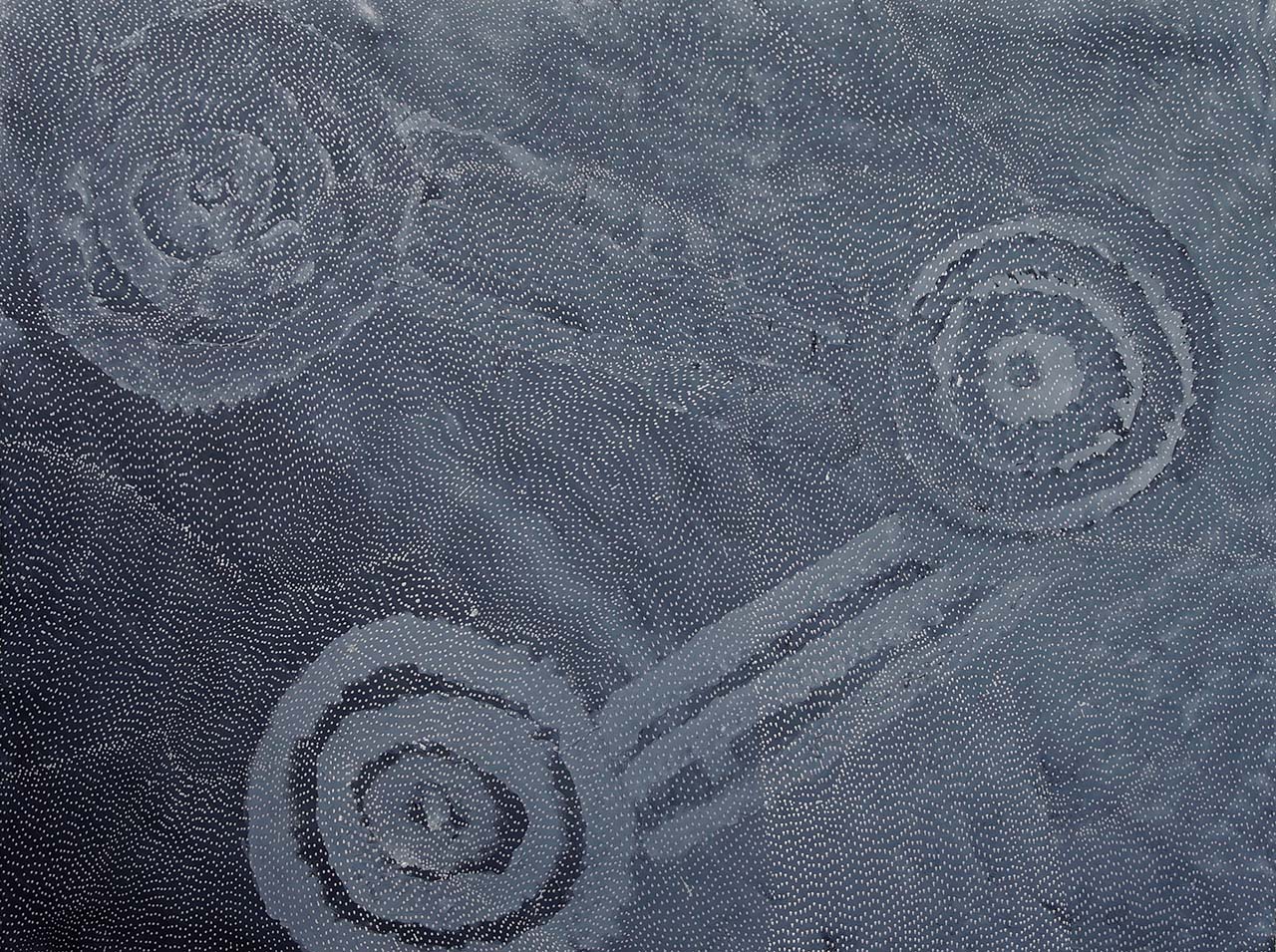
You’ve got these major waterholes or ancestral spirit motifs that are slightly emerging from underneath a complex pattern of dots, almost waves of dots moving across the painting which show many different layers of life and spirituality. It’s a beautiful and powerful painting, and it exemplifies the staggering talent of this incredible artist.
Awely (Body Paint) by Susan Pitjara Hunter
The other painting that continues to stay with me, and we’ve got it actually on display in our downstairs gallery now, was from our very successful “Camel Camp & Beyond” exhibition. That exhibition highlighted works from one of the most famous artistic communities, Utopia, a remote community some 270 kilometres Northeast of Alice Springs, right in the heart of Australia in the central desert.
The painting in particular was Awely (Body Paint) by Susan Pitjara Hunter.
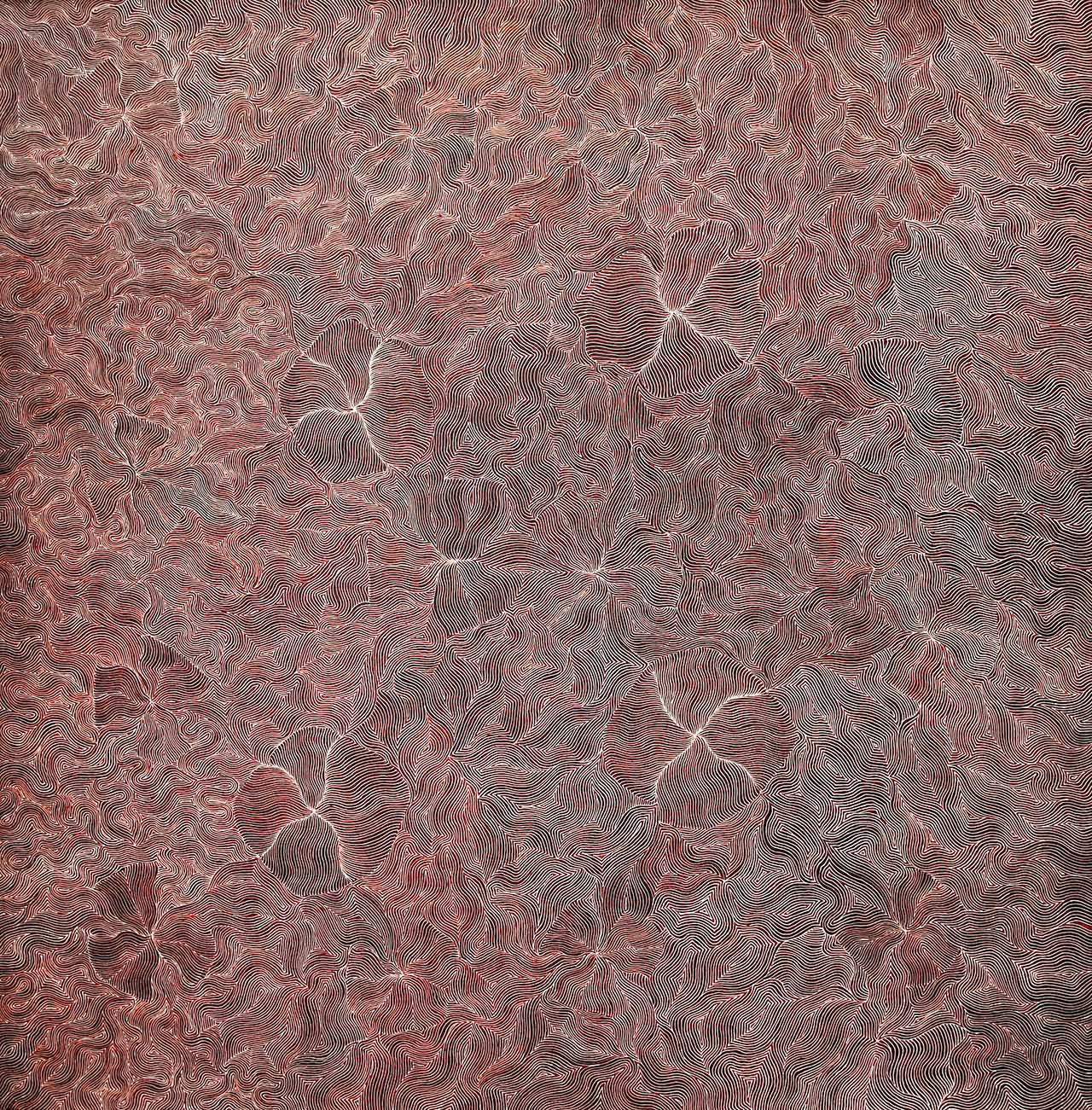
It’s quite a large work, measuring 180 centimetres by 180 centimetres. It’s incredibly finely worked. Unlike most Utopia paintings, it’s not very fine dots but rather very, very fine lines with just subtle changes in colour that radiate across the painting. Really, the talent of this artist and the patience and the skill are just staggering. The painting is unforgettable, and continues to draw the eye of anyone who visits the gallery, who are all of them staggered by the talent of this particular artist and the effect of this painting on your heart when you look at this painting. It is remarkable.
Wiyini Jilamara – Leaves Bodypainting Design by Maria Josette Orsto
One of the other memorable paintings from our exhibition programme this year comes from our work with Tiwi Design on Bathurst Island, which is North of Darwin. Tiwi Design is an Indigenous owned and run art centre. It is known for some beautiful cross-hatch designs, and renowned for its wooden sculptures which are painted in ochre pigments. All of the paintings are also done in ochre pigments. Their paintings are usually very well observed images of animals, sea life, totems and birds. They are very distinctive and couldn’t come from anywhere else.
With this exhibition, we featured one of the emerging artists from that community, Maria Josette Orsto. She has a unique style in that she works in ochre pigments. She works on canvases as well as barks and sculptures. In this particular instance, what took my eye was one of her paintings. Maria paints with a comb like wooden object. She can apply five or six dots on the canvas at a single time, so you don’t so much have the cross-hatching but you have the dotting technique which just fills up this complex pattern.
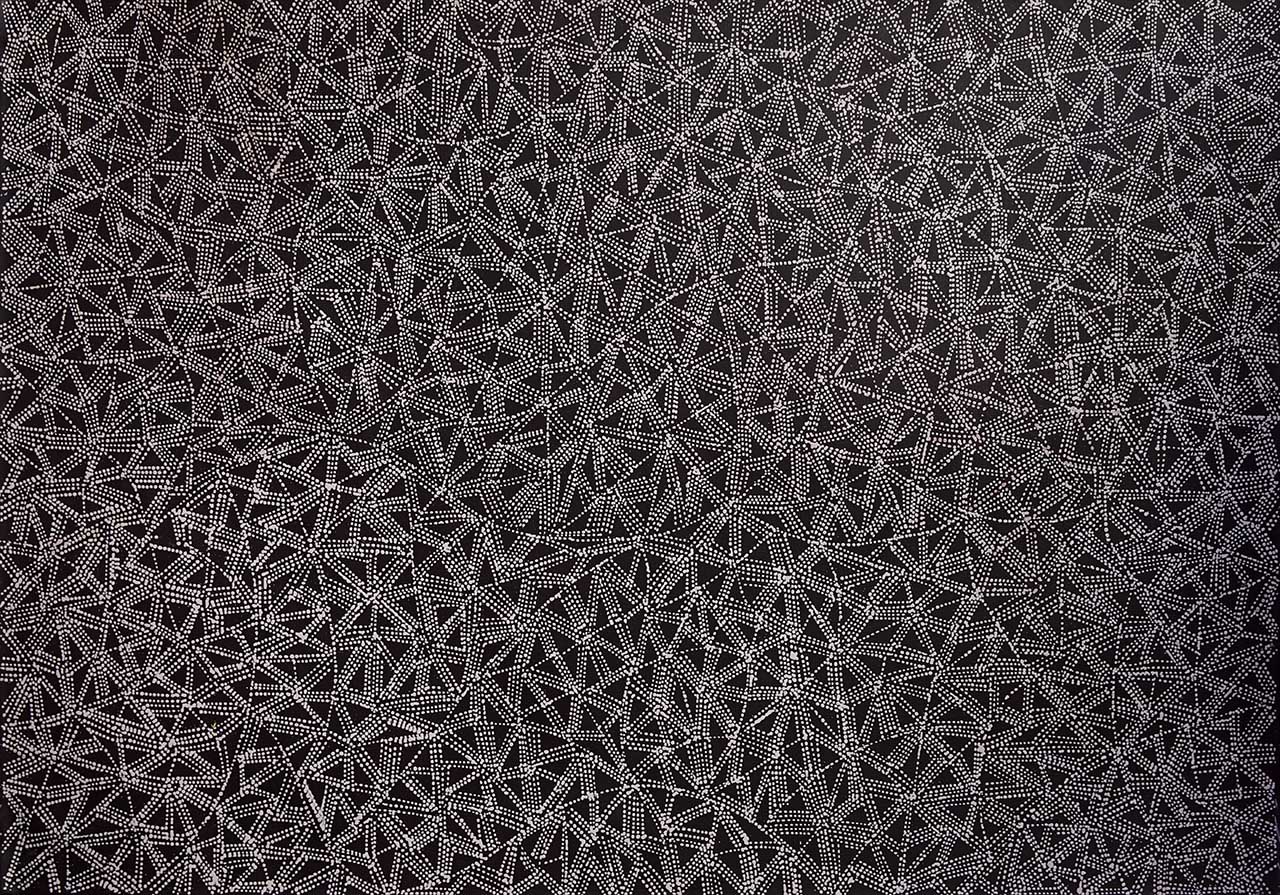
This particular painting, which measures 150 by 100 centimetres, which was called Wiyini Jilamara, is a beautiful and complex painting. There’s a timeless element and sophistication to it that belies the simple way in which it was created. It has these central elements and little focuses of dots that draw your eye into the canvas. I really love this painting, and it’s something that we’re very privileged to have on display here at the gallery.
Mina Mina Tjukurpa by Elsie Napanangka Granites
The final painting that rounds out my top six for the year would be from our final exhibition, a solo exhibition for Elsie Napanangka Granites
I set myself the task of choosing six paintings that speak to the heart. But there were so many others that I could also mention which I really loved – you only need to look at the works of Rosella Namok (whose works I love) and Fiona Omeenyo to see works that have a profound effect upon so many people.
The final work of the year I’ve selected that really drew me in is not a major painting – it measures just 122 by 122 centimetres. It’s by Elsie Napanangka Granites, a Warlpiri artist who works in incredibly fine dot work.
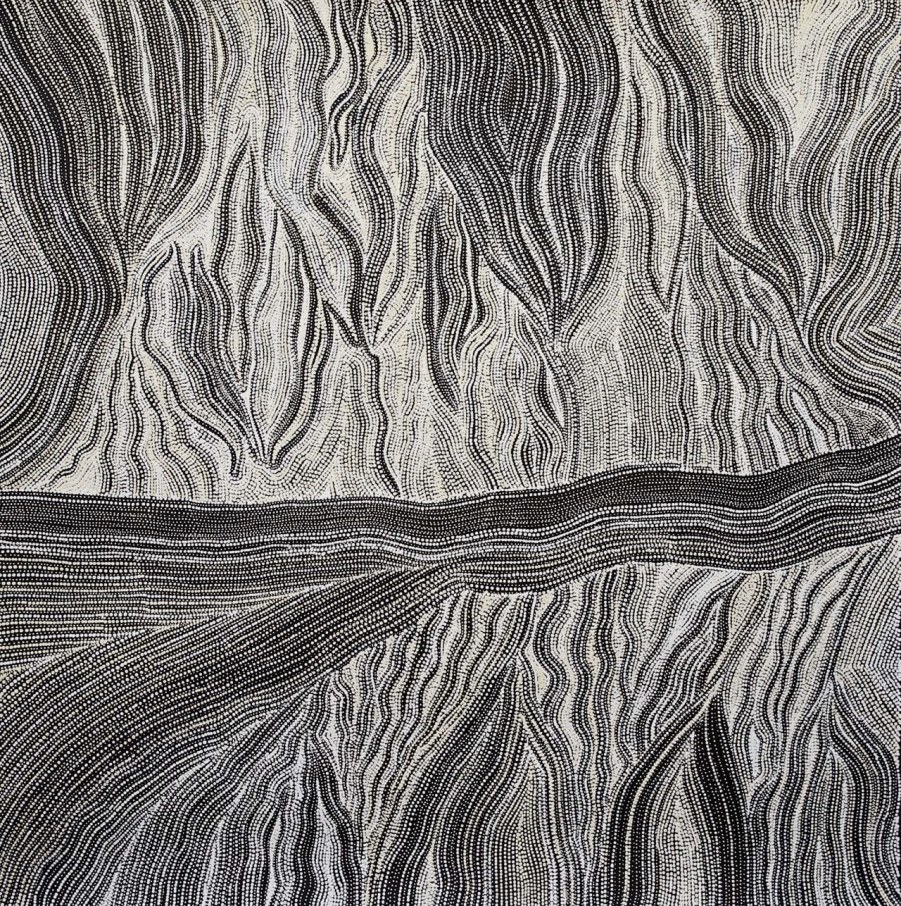
It’s not just the fact that Elsie is so skillful and meticulous with her dots, it’s the way she works up the composition. This particular painting, called Mina Mina Jukurrpa, is a particularly powerful piece. It’s an aerial view of part of her country. You’ve got what appears to be a riverbed running through it, and all the little water run offs running off into the distance and then into the sand hills. This is just created with flowing rivers of dots and just subtle variations of palette and complexity and density.
It is a beautiful piece. Mina Mina is a very important area, a powerful and ancient place for womens’ ceremony. As a male, I’m not allowed to know all the complexities and the depth of the story behind it, but I can’t help but be drawn into this painting and to not be effected by it. As an aerial view of landscape, or as an abstract work, it is such powerful piece. Knowing that it has an intense and powerful spiritual meaning behind it just adds to its attraction and to its mysticism. I’d love to know more, but as a male I never will be able to. That draws me to it as well.
There have been so many wonderful paintings this year, it’s been one of our best exhibition years ever. It is such a pleasure to look back over these works.
Further information and resources about the artists
Bedford Station by Rover Thomas
Ngarrk Ngarrk by Alan Joshua Jr
Gurindji Mirrwula by Sarrita King
- 2016 Exhibition: Sarrita King & Tarisse King
- Sarrita King Paintings
- Sarrita & Tarisse King – Reflecting On Gurindji and Wave Hill
- Paintings from Darwin
Awely (Body Paint) by Susan Pitjara Hunter
Wiyini Jilamara – Leaves Bodypainting Design by Maria Josette Orsto
Mina Mina Tjukurpa by Elsie Napanangka Granites
